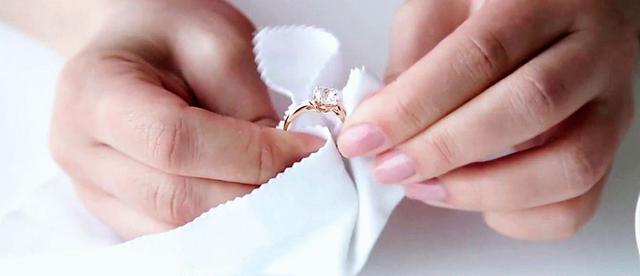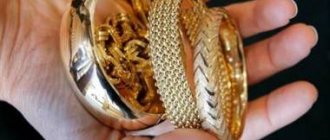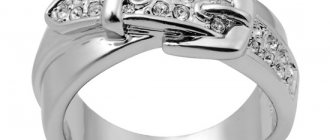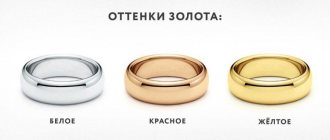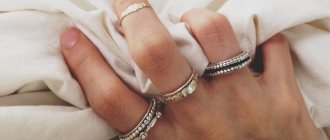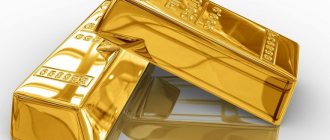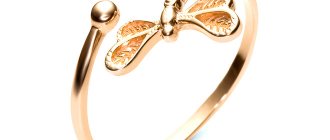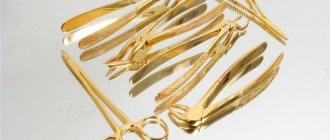What is it and why is it called that
There is an opinion that pure gold of the 999th standard is called medical. This is wrong. Pure gold is too soft a material, and its cost is high. All gold products in the world are various alloys of the main element and auxiliary ones.
Composition and properties
The alloy usually contains metals that have a shine. Sometimes it doesn't include a single ounce of AU. They try to combine in different proportions:
- zinc;
- copper;
- nickel;
- chromium;
- molybdenum;
- manganese;
- magnesium;
- titanium;
- silver;
- brass.
The alloy does not have a single composition; variations are possible. To obtain the white metal, titanium is added. This alloy is also called surgical; surgical instruments and dentures are made from it.
Expert opinion
Vsevolod Kozlovsky
6 years in jewelry making. Knows everything about samples and can identify a fake in 12 seconds
The main advantage of the alloy is its availability and durability. The variety of combinations of metals allows us to produce jewelry that closely resembles precious ones.
Strength
Items made from medical alloy have increased strength. Jewelry has to be produced in simple shapes. But surgical instruments have the necessary hardness, and dental crowns do not wear out.
Shade range
The combination of components gives the medical alloy shades from light yellow to reddish. The use of different technologies for coating objects allows you to choose two colors. The decoration can copy white or yellow gold.
Does the sample
The test is applied to products made of precious metals. There is no sample less than 375. Jewelry containing a smaller amount of AU is classified as costume jewelry and is assigned a different label.
Expert opinion
Vsevolod Kozlovsky
6 years in jewelry making. Knows everything about samples and can identify a fake in 12 seconds
The term “gold” for such an alloy is an advertising ploy that attracts buyers and inspires consumer confidence. The steel used for production is marked 03Х17Н14МЗ or 12Х18Н10. Products from America and Great Britain are marked with the mark 316L. The product must have a stamp, article number, and manufacturer's mark.
Does honey gold turn black?
Products made from medical gold retain their appearance for a long time. They do not darken when exposed to salt water, which can be a good solution for lovers of jewelry on vacation by the sea. The sun's rays also do not cause noticeable harm. Many women have had annoying troubles associated with the loss of their favorite ring or chain at sea. I think it’s a great idea to buy a couple of beautiful jewelry before your vacation that you don’t mind losing because of their low cost.
Jewelry is not affected by chlorinated tap water, which allows you to fearlessly wash your hands without removing the rings.
The only enemy of products is time. They simply wear out, steel begins to show through the coating, and they have to be replaced with new ones. The alloy cannot completely replace noble metals.
What is medical gold?
Products made from medical gold are visually similar to high-grade gold jewelry. At the same time, they really do not darken or lose color or shine thanks to a special polishing and spraying technology.
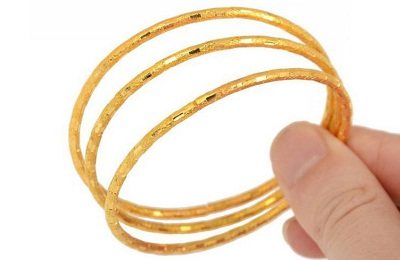
In addition, such jewelry has a significant advantage over gold jewelry: they do not cause allergies in people suffering from contact dermatitis when wearing precious metals. Medical gold has higher strength than noble metal, therefore it is not subject to various scratches and damage, and jewelry made from such material looks just as aesthetically pleasing and solid.
So, we've looked at the benefits of medical gold over regular gold, but what is it? Medical gold is a special metal alloy, the composition of which can vary depending on the needs of the field of practical application. Medical instruments are made from this alloy, dental crowns were previously made, and now jewelry is mainly smelted from it.
An alloy of medical gold may contain silver, brass, copper, zinc, titanium, but gold itself may be completely absent - the alloy, with a certain combination of silver, copper and brass, itself has a noble yellow luster.
The demand for medical gold is due to the fact that real gold (especially in its pure form) is very soft, ductile, and it would be impossible to use it, for example, as a crown for a tooth - it would instantly wear out.
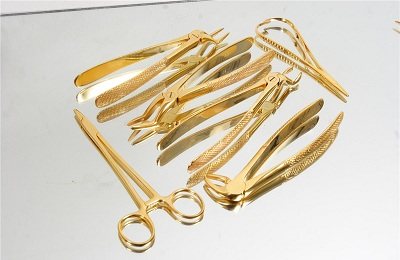
Instruments made of gold would also wear down very quickly, and in the context of surgical instruments this is not only dangerous for the patient, but also very expensive. Therefore, it was decided to make an alloy with optimal density and wear resistance characteristics, which, among other things, turned out to be very aesthetic, which jewelry manufacturers soon took advantage of.
Medical gold, despite all its advantages, is valued tens of times cheaper than the precious metal. Speculators often take advantage of the external resemblance of the alloy to real gold, creating a multiple markup when selling and passing off jewelry made from the alloy as jewelry.
Methods of obtaining
To obtain products that look like precious metal, the steel alloy is plated with gold. The most popular methods of gilding:
- Gold Filled – rolling. The workpiece is covered with the thinnest gold sheet, which is attached to an oil or adhesive base. To make the surface shiny, use glue, and if you want a matte surface, use oil varnish. On products coated with this method, it is necessary to indicate how many carats the gold leaf had.
- Gold Plated – by galvanic method. The product is polished, degreased and cleaned of the effects of oxidation. A thin layer of gold plating is then applied using an electric current.
To obtain a white tint, the object is coated with PVD. Vapors of precious metals are sprayed onto the product under vacuum, and it acquires a cool white shine.
In addition to spray-coated steel, various alloys are used. In Europe you can find an alloy of copper and zinc (9/1). Copper is cleaned, polished, and becomes like real gold.
If aluminum is used instead of zinc, the resulting product is called aural (aufor, aufir). In Germany this alloy is known as goldin.
There is a coating called music. It is based on tin and does not lose its qualities under the influence of environmental factors.
The combination of copper, zinc and tin is sold under the name Mannheim gold, and mosaic gold is a composition in which copper and zinc are almost equal.
The more copper, the lighter the resulting color. In French gold it is 80%, and zinc is only 15%. Decorations made from it are light yellow.
Purchased cleaning products
A gentle method for cleaning medical alloy products is ultrasonic exposure using a special device. This device cleans gold, silver, platinum and jewelry. In addition, jewelry with precious or semi-precious stones is cleaned in this way.
To clean, place the item in the device for a couple of minutes. After the procedure, the jewelry will shine with shine and purity. This method will allow you to keep your jewelry in its original form after many years.
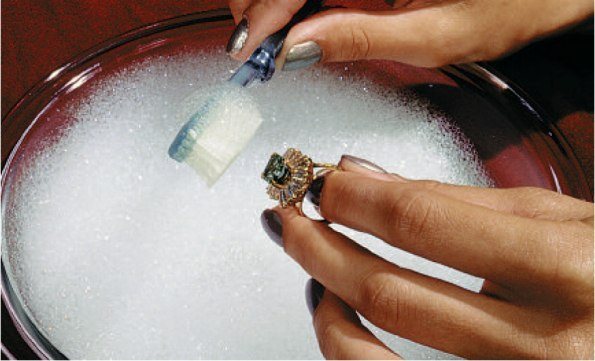
How to clean medical alloy jewelry yourself
When cleaning alloy products, the use of products containing coarse-grained solid abrasives is prohibited. This may cause damage and remove shine. An excellent solution would be a soft or finely dispersed composition that is used to clean metal. These substances contain wax, ammonia, organic solvents, etc.
In a situation where medical alloy earrings have lost their shine, it is recommended to wash them in a mixture of warm water and a washing liquid that does not contain aggressive substances. Next, the jewelry should be rinsed in a sodium hyposulfite solution. The composition is mixed in proportions of 20g per 100ml of water.
Among modern cleaning products, “Asidol” and “Jewelry” pastes are an excellent solution. To get rid of dirt, it is recommended to apply the product to flannel or woolen material and wipe the surface.
Alloy Application
In addition to the jewelry industry, the alloy is actively used in medicine. Instruments for surgical operations have the necessary strength, and dentures, thanks to the gold particles included in the composition, do not come off.
Now the latest developments make it possible to include small particles of AU in medications for oral administration as a cure for cancer and other diseases.
In cosmetology, gold threads are used to strengthen facial contours, masks and wraps with gold, and cocktails with AU inclusions.
The alloy is used to produce safe stud earrings, which are the first to be inserted into a fresh earlobe piercing. Wristwatches, men's accessories, and eyeglass frames are made from it.
Tools for manicure and pedicure made of medical gold are of high quality, durable and beautiful.
Composition of alloys for surgical steel
But ordinary stainless steel is also not suitable for the manufacture of medical instruments and equipment. Other properties that are achieved by adding various alloying elements to the alloy are also important. For such purposes, a medical alloy is used, mainly molybdenum, chromium and nickel.
Molybdenum alloy
It is used to make equipment and instruments (scalpels, cutters, dental burs), as well as high-quality glassware used for medical purposes. Molybdenum significantly improves the mechanical strength characteristics of steel: it becomes resistant to temperature changes, while maintaining its primary properties. That is, even if the instrument is greatly overheated or overcooled, it will not become more fragile and will not corrode.
The amount of molybdenum in surgical steel can vary from 0.2 to 0.5%. This is enough to provide the necessary strength and durability. Molybdenum is a fairly expensive alloying element, and increasing its content in the alloy increases the cost of the finished material. But all costs are justified when it comes to the health and life of patients.
Chrome-nickel alloy
It is used for the manufacture of dental and surgical instruments, utensils, and equipment. The main property of chromium-nickel steel is its excellent resistance to corrosion and oxidation. For example, braces are made from it, which a person can wear for several years. In this case, the locks will not rust, there will be no metallic taste in the mouth, etc.
The most popular grade in medicine is called: steel 18/10, where 18 is the percentage of chromium, 10 is the percentage of nickel. It also contains 0.12% carbon. All this gives steel appliances high density (there are no micropores on their surface through which germs and dust could enter) and hardness (the surface is not susceptible to chips and scratches).
Ferritic chromium alloy
Its scope of application is devices and equipment that are often exposed to high temperatures. Ferritic-chromium steel is used to make sterilization boiling containers, as well as dental prostheses and some devices. Additionally, it has high ductility and a long service life.
The maximum temperature of the finished product depends on the percentage of chromium in such steel. It reaches a maximum of 1050 degrees. If you additionally alloy the alloy with molybdenum and nickel, you will get a mixed grade that will withstand up to 600 degrees.
By the way! The blades of some tools are additionally processed, for example, by diamond coating. This makes it possible to give them even greater hardness and strength, and, accordingly, increases the cost.
How to distinguish a medical alloy from gold
I think that you can easily distinguish precious metal from costume jewelry. In large stores that care about their reputation, no one will try to sell a fake under the guise of a real product. Good jewelry is highly valued by women; it allows you to complement your look with jewelry at a budget price.
But if you are in doubt about an item, evaluate its parameters to understand whether this is a precious metal or a jewelry alloy:
- Availability of sample. Precious items will bear the hallmark of the Assay Office. Products of 585 fineness, beloved in Russia, will have an imprint of the head of a girl in a kokoshnik and the numbers - 585. For jewelry from the Soviet period, instead of a girl’s head, there is a five-pointed star, inside of which there is a sickle and a hammer, and next to it there are numbers indicating the fineness - 585, 850. For medical gold - stamp that looks like a line – 03×17n14mz.
- Price. For precious metals it is much higher.
- Stones. If the item contains diamonds or sapphires, the item is most likely gold. Expensive gems are not used in jewelry.
- Weight. Real gold is massive, the heaviness is well felt. Costume jewelry is much lighter, which allows manufacturers to produce large chains and earrings. This rule does not always work, because many non-precious products are heavy.
- Shine. Non-precious products shine brighter and more easily, while precious ones have a noble, muted tint.
- Scratch. Gold is easily damaged due to its softness, while jewelry metals are durable and weakly resistant. It is better to scratch with a real ring with a reliably known sample. Remember: if you scratch your gold jewelry, you will damage an item that does not belong to you, and the seller will be entitled to claim compensation.
- When the decoration is already at home, you can test it with iodine. To do this, select an inconspicuous area on the product and place a drop of iodine. Real precious metal will oxidize and the stain will remain forever (so the area should be invisible!). Iodine can be easily wiped off from other formulations without a trace.
- The jewelry can be valued at a pawn shop. The technician will use an x-ray to determine the thickness of the coating and determine the cost of the item.
Surgical steel criteria
There is no “surgical” brand as such. No state standard regulates its chemical composition and mechanical properties. This is more of a popular concept used within specialists to designate the material that is used to make medical instruments: scalpels, clamps, etc.
There are some requirements that determine whether steel belongs to this group. The main criteria here are the following parameters:
- Porosity.
- Corrosion resistance.
- Hardness.
Let us now examine each point in more detail.
Surgical steel is characterized by low porosity, i.e. small distance between metal grains. The fact is that large pores are a place for the accumulation of bacteria, which subsequently cause the spread of infection throughout a living organism. Disinfection does not help in this case either. The outer layer of microorganisms prevents the disinfectant solution from penetrating into the pores.
The surgical grade of steel must be resistant to water. Do not oxidize or form rust when interacting with atmospheric gases. Be inert towards living tissue. Do not react chemically with most types of organic and inorganic acids. Should not be toxic.
The presence of high hardness is necessary to ensure a sharp cutting edge of the blade. The tool should not bend when exposed to mechanical loads. Hardness extends the life of the tool. In addition, do not forget about strength. The blade should not be sensitive to the formation of cracks and chips upon impact.
All of the above criteria impose some features on the chemical composition of the surgical grade:
- The carbon content should be 0.4-1.2%. Carbon is an integral part, along with iron, for any steel. It is carbon that is responsible for the hardness and strength of steel alloys. When iron interacts with carbon, carbides are formed, which are larger in size and have improved mechanical characteristics. In addition, carbon makes it possible to further strengthen steel by heat treatment. But you shouldn’t abuse this element either. When carbon is added to the steel composition above 1.2%, an effect such as brittleness begins to form.
- The presence of chromium is at least 13%. Chromium is the first most popular alloying element for steel. It crushes the grain of the metal, thereby promoting hardening. Chromium oxides, which form in the form of a thin film on the surface of steel, protect it not only from aggressive environmental influences, but also from elevated temperatures. Just like carbon, chromium increases the hardenability of steel, i.e. makes the metal more sensitive to heat treatment.
- Manganese (up to 1%) and silicon (up to 1%). Must be present in any steel. They are deoxidizers: they remove oxygen from the metal that got into its composition during smelting. They have a beneficial effect on the mechanical properties of steel: they increase impact strength, relieve residual stresses, and reduce the heterogeneity of its chemical composition.
In addition to these elements, surgical steel can be additionally alloyed with nickel. Compared to chromium, it has a stronger effect on corrosion resistance and heat resistance, but at the same time its price is higher. Significantly increases the fatigue strength of the alloy, i.e. its ability to resist cyclic loads. Increases the impact strength of the metal and its susceptibility to thermal hardening.
Some grades of high-alloy steels meet all of the above criteria. Among them, the most popular are 95X18, 40X13S and 65X13. Several foreign analogues are known:
- 1.4125 (Germany).
- SUS440C (Japan).
- 440V (USA).
- Z100CD17 (France).
Advantages and disadvantages
Every woman decides for herself whether it is worth buying jewelry that is not precious.
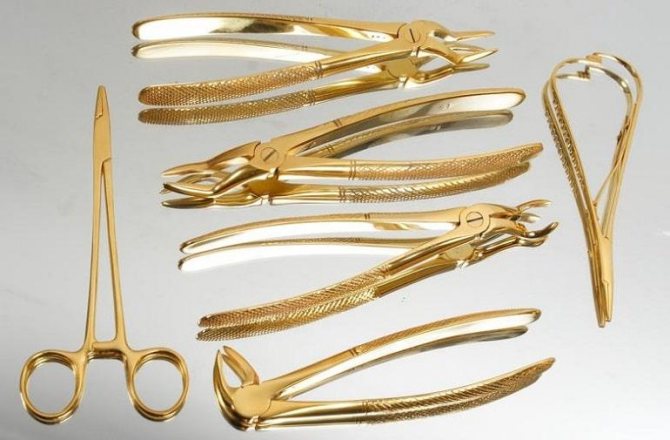
The popularity of medical gold is due to its properties:
- It perfectly replaces precious metals as jewelry and looks no worse.
- It does not cause allergies, which makes it possible for people who are allergic to gold to wear items made of yellow metal.
- It doesn't get dark.
- It's inexpensive.
- Items made from it are durable and last a long time.
Despite such serious advantages, jewelry also has disadvantages:
- Abrasion of the surface layer over time. No matter how much you take care of your favorite chain or ring, sooner or later they will have to be replaced.
- The lack of hallmark on the product makes it not a good investment, as is the case with gold, but simply the purchase of a fashion accessory.
Negative aspects of medical alloy
No matter how attractive medical alloy products may be due to their advantages, they, like any product, have a number of disadvantages:
- Unlike precious gold products, medical steel can wear down over time even though it successfully resists corrosion and has a long service life. If the product is not cared for carefully enough, subjected to mechanical stress and frequent chemical treatment, the protective layer will wear off over time.
- Many lovers of jewelry made from medical gold consider the lack of hallmark on the jewelry to be a disadvantage. The reason is that they do not belong to the class of jewelry.
- If we compare the prices of jewelry made of medical alloy and ordinary jewelry, then in the first case it is several times higher .
- We must remember that abrasive detergents should not be used .
- There is a risk of purchasing a fake, because it is difficult to determine the quality level of the alloy with the naked eye.
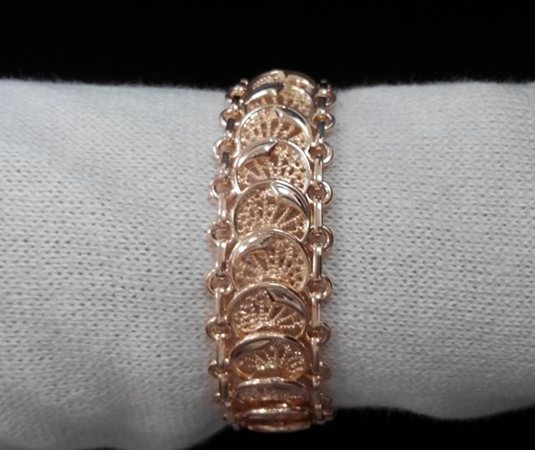
Where can you buy or sell
You can buy jewelry in large jewelry stores in Moscow or other regions of Russia. They often have departments selling costume jewelry made from alloys with semi-precious stones. Online stores also offer a large assortment of medical gold; you just need to enter a query in a search engine.
The catalogs contain detailed photos, which allows you to choose jewelry without leaving your home. The order can be delivered by courier, transport company or Russian Post.
Expert opinion
Vsevolod Kozlovsky
6 years in jewelry making. Knows everything about samples and can identify a fake in 12 seconds
But if you are not an entrepreneur, you can sell jewelry only through private advertisement sites. Pawnshops rarely take gold-plated items. In the best case, if the coating is significant enough, they give a very small price for it.
Features of caring for medical alloy
Medical alloy products must be stored separately from other items. For jewelry, a capacious box is suitable, in which the jewelry will not touch each other. This precaution will protect items from scratches and other damage.
It is strictly prohibited to store products in plastic boxes and plastic bags. This is a very harmful environment for jewelry, which leads to darkening. It is recommended to remove alloy jewelry before playing sports and before going to bed. Otherwise, product deformation or breakage may occur.
Jewelry should be put on last, after perfume and hairspray have been used. Products should not be exposed to high temperatures. The medical alloy coating may deteriorate in direct sunlight. It is not recommended to wear jewelry on the beach, in the sauna, solarium, etc.
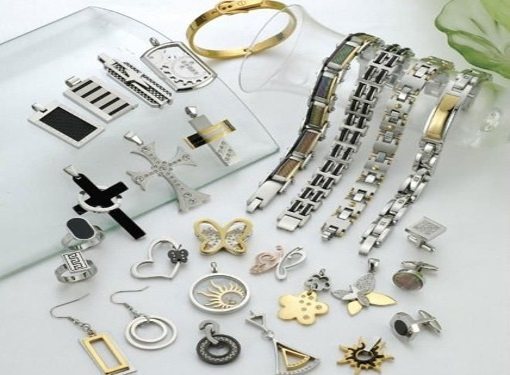
Features of cleaning products made from medical alloy
Products should be cleaned from time to time. To do this, both methods that can be done independently and professional cleaning methods are used. If precautions are taken, the medical alloy will last a long time, maintaining an attractive appearance.
Tips for choosing jewelry
When planning the purchase of jewelry, it is worth considering some points to minimize the risk of purchasing a low-quality item:
- Costume jewelry does not have the usual gold standard, but it has its own marking. A conscientious manufacturer will indicate on the stamp the amount of impurities and the number of carats of gold plating, if any. Carats are designated by the letter K and a number. 375 standard - the lowest for gold - is marked 9K (British system) or 36K (Russian system). Anything containing fewer gold carats is a jewelry alloy.
- The decoration is accompanied by a tag indicating the manufacturer, his details, and alloy composition. If stones are present, then information about them.
Classification of medical steel
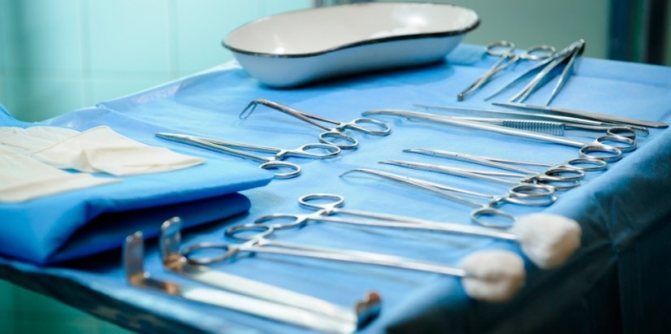
Today, the following groups are distinguished by composition:
- Molybdenum chromium. It has high mechanical strength and is resistant to elevated temperatures, which is extremely important in the sterilization process. The disadvantage of the material is its significant cost, since its structure includes an expensive metal - molybdenum.
- Chrome-nickel. This alloy contains chromium and nickel. It is extremely resistant to corrosion and acidic and alkaline environments.
- Chromium ferritic. This is the most popular material. It is very durable, but tools made from it can be easily processed: sharpened and adjusted. This material is resistant to microscopic cracks and is characterized by high anti-corrosion properties.
The most popular Russian medical steel is grade 18/10 or 12X18H10. It is similar to the German standard X5CrNi10-10. In the European EN system it is designated 1.4301.
Reviews
Natalya “I decided to check my rings to see if they were gold. The iodine method works, there are traces left on mine. It’s good that I didn’t think of smearing iodine on a cotton swab, but used a thin needle!”
Olga “I’ve met such shops with medical gold. Somehow I didn’t trust it, I was afraid, I thought it was some kind of fake. Now I understand that it is not a fake, but simply something completely different than gold. I’ll have to buy a set for the holiday!”
Irina “I had a bracelet made of medical gold. I wore it for about a year, most often I wore it in winter, in summer I don’t like jewelry on the skin. The lock was wiped first, then the links that were located nearby. The metal itself under the gilding turned out to be dark. But I enjoyed the year.”
How to purify medical gold
The market today offers a wide selection of pastes, tonics, which are described as looking for medicinal gold. Here's a quick tip about food: how to clean medical gold is not difficult, but it can be done at home. With this method you can use offensive warehouses:
- The simplest and cheapest - rarely nice - or shampoo. To do this, add a few drops of shampoo or milk to a bottle with running water, and soak some fabric pulp in this container. And after that the surface of the germs is wiped.
- A similar option for cleaning seeds from contamination is to use a mild solution of boron, alcohol, alcohol, and turpentine.
- For cleaning, brush soft fabric, harsh washcloths, and toothbrushes can remove micro-stains on the surface, which will cause the brood to clog.
Before cleaning the jewelry, you need to wipe it with soft bristles or cloth. It is not recommended to clean medical gold in warehouses in order to remove chemically aggressive components. After processing, it is recommended to polish the stain with a soft cloth.
